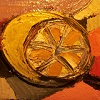Hi there,
I'm new to this forum and followed the discussion so far with great interest.
I've bought a Citsuma Prague plant from Bernhard Voss last year and followed its growth accurately.
According to what I've read and seen till now I came to this (possible) conclusions:
-The Citsuma Prague is a periclinal chimera, possibly with the layers L1 and L2 of Satsuma and the L3 of Poncirus. The periclinal is a stable form of chimera.
This would explain why the leaves show Poncirus influence and the fruit not. The L1 and L2 layers are responsible for the peel and fruit/seed formation. The L3 layer forms the stem core and the central region of the leaf.
If I can see it right in the photographs of autumn leaves posted here it's always the inner part of the leaf witch became brown (showing the tendency of Poncirus to lose the leaves in autumn).
To see the Layering of Periclinal Chimeras you can go to this page:
http://generalhorticulture.tamu.edu/hort604/lecturesuppl/anatomychimeras/anatomychimeras05.htm
-The Chimera probably originated from a frozen Satsuma grafted on Poncirus Trifoliata.
This is for me the more plausible option since it is really difficult to obtain a chimera artificially.
Another similar case is +Citroponcirus `Hormish' which you can see at the end of this page:
http://www.homecitrusgrowers.co.uk/citrusvarieties/bizzarria.html
The chimera arises from the graft union tissue which is a chaotic conglomerate of cells of the two species.
For me it seems plausible that if all the Satsuma cells of the grafted plant died except of the ones in the graft conglomerate (from which than the chimera arose) than this means that the Poncirus cells mixed so close with the Satsuma ones give them some cold hardiness. If this wouldn't be than also the Satsuma cells in the graft tissue shouldn't have survived.
This could explain the great cold hardiness of the Citsuma Prague.
-The Citsuma Prague is possibly affected by the Psorosis Virus.
I came to this conclusion because of many reasons:
1. As soon as I saw the first growth of my plant this spring I notice the clear oak leaf pattern associated to Psorosis, Concave gum, Cristacortis or Impietratura virus in the fresh leaves. The pattern disappeared in the mature leaf.
2. The new growth was strange. The plant formed long branches in which the first leaves where tiny and soon fall of and than few leaves growth on the top.
I saw this growth again this autumn with low temperatures. The stunting effect on leaves was much stronger. Almost all leaves died, just a few chlorotic ones resisted but never turned green, the stem was stunted and chlorotic.
This wouldn't happen on a healthy plant and seems the effect of psorosis on young growth at cool temperatures (see
http://ecoport.org/ep?SearchType=pdb&PdbID=1432 )
3. Plants affected by psorosis produce few to no crop. This could be the reason why the Citsuma Prague is such a shy bearer.
4. On the page of snek I read about the Citsuma Prague:
"Often, however, for no apparent reason dies . Bark at the older wood scaly and peeling off some twigs are cut in the bark reddish . Poddoné symptoms are infected with citrus psorosis . The similarity may be purely coincidental."
Bark scaling on older branches and red parts in the trunks are also symptoms of psorosis and plants affected by this virus often die.
-Satsuma is affected by Psorosis, Poncirus is a simptomless carrier.
I think that this Citsuma Prague is an incredible plant, that combines the hardiest citrus, the Poncirus, with the earliest ripening citrus, the Satsuma making it an exellent plant for cold areas.
If there would be a possibility to free the propagation material from this (possible) infection I think that we could get a plant that is also productive, faster and more upright growing, maybe even more cold hardy (virus affected plants are less freeze tolerant).
The plant should be tested for Psorosis and then Thermotherapy or Shoot Tip micrografting should be used to get rid of the pathogen.
Other graft-hybrids should be imported and tested for cold hardyness like "Kinkoji unshiu mandarin" (
http://www.citrusvariety.ucr.edu/citrus/kinkoji_unshiu.html), +Citroponcirus `Hormish', "Kobayashi-mikan"..







